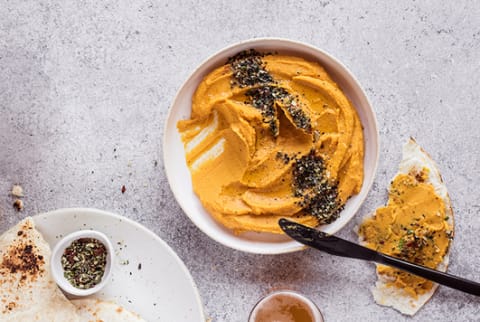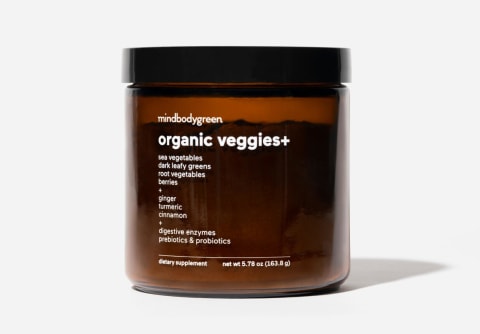Advertisement
Bored With Salad? 5 Genius Ways To Eat More Greens


Most of us already know how important it is to eat our greens. After all, healthy greens are excellent sources of nutrition, offering myriad vitamins, minerals, antioxidants, fiber, and even hydration. As a registered dietitian, I see a ton of clients weekly who have trouble meeting their daily green requirements. I hear, "I'm bored with salads" and "I can't drink another smoothie" constantly. The fact of the matter is that salads are not the only way to eat more vegetables, and salad greens are not your only option.
The best greens to add to your diet.
Increasing your vegetable intake is a lot easier than you think, if you think outside the box. We already know that spinach and broccoli tend to be the most popular greens, so let's take a closer look at the healthy greens you may be less familiar with—and exactly how to use them.
Kale
I'm not sure I've known a vegetable to receive as much attention as our beloved kale, but a lesser-known fact about this veggie is that there are many varieties of kale. While we're likely familiar with the flatter, wider leaf, there are smaller, curlier leaves known as starbor and darkibor. All types boast super-high levels of vitamins K, A, and C, and this superfood is especially recognized for its antioxidants lutein and beta-carotene. Lutein plays a major role in promoting ocular health by protecting the eye from both potential light and oxygen damage.
Kale is a great addition to a breakfast frittata or omelet, or use it in a classic white bean and kale soup to eat more vegetables throughout your day.
Mustard greens
One cup of cooked mustard greens has more than nine times the daily value of vitamin K and is an excellent source of vitamins A, C, and E. Remember, vitamin K is essential for blood clotting and supports bone health by facilitating the transport of calcium. Mustard greens are also packed with minerals like copper, manganese, and calcium. They're not only strong antioxidants, but they may also have digestive benefits as they contain compounds that support the cells lining the stomach and gastrointestinal tract.
Mustard greens are especially palatable when sautéed. Consider a sauté with apple cider vinegar and sweet onions.
Artichokes
While loaded with vitamins and minerals, artichokes should be highlighted largely for their antioxidant capacity, fiber content1, and cholesterol-lowering properties. The phytonutrient compounds found in artichokes scavenge otherwise harmful free radicals. This system actually helps to combat inflammation that may cause disruption to normal bodily functions.
Steamed artichokes can be served as a stand-alone dish, or they're tasty in a tapenade. Serve them in a healthy, Greek-yogurt-based spinach and artichoke dip at your next gathering.
Watercress
Watercress is so much more than a green addition to fancy sandwiches. This tangy-tasting cruciferous plant and nutrient powerhouse2 is loaded with vitamins and minerals, namely calcium and potassium. In fact, it provides more calcium than milk. Watercress also contains vitamin C, vitamin K, magnesium, and more.
The green superfood is great option if you want to eat more vegetables, without getting bored. Try it in a salad with sweeter notes, like those from pears and cranberries.
Brussels sprouts
Just 1 cup of cooked Brussels sprouts provides more than two times the daily value for vitamin K and more than 100% of the daily value for vitamin C. These sprouts are also rich in compounds called glucosinolates, which help to reduce systemic inflammation and thus may help prevent the development of many chronic diseases.
Roasted Brussels sprouts make for a delicious side dish, or sneak some shaved Brussels sprouts into salads or pasta dishes.
Dandelion greens
Have you ever admired a patch of yellow dandelions in a wild, grassy area? Believe it or not, these pretty little plants, often labeled weeds, have a lot more to offer than just a budding flower. The green leafy portion of this plant boasts an impressive nutrient profile. Dandelion greens are loaded with vitamins A, K, and E and are a good source of calcium and iron.
While they're fantastic in salads, you can also cook them in a bean or legume side dish and complement it with garlic or onions. They also work well in an omelet or ground into a pesto sauce.
Green bell peppers
While lots of focus is given to their colorful counterparts, green bell peppers3 sometimes get lost in the crudités mix. After all, it's easy to overlook the green when juxtaposed with the vibrant red, orange, and yellow. However, they are high in vitamins A and C and folate, which helps to support red blood cell function. Bell peppers are good sources of dietary fiber, which provides a range of health benefits, from promoting digestive regularity to even reducing cholesterol.
Green bell peppers are perfect for any cruciferous stir fry, or they can be eaten raw in a crudités mix. For another way to eat more vegetables, try them in an artichoke hummus or scallion vegetable dip for an extra boost of greens.
Microgreens
Have you ever noticed those little greens that often decorate your omelet at a restaurant, or that may garnish a soup or sandwich? If not, it may be because you habitually move them to the side of your plate to be discarded at the end of your meal. Well, next time you notice those little decorative greens, also known as microgreens, don't toss them. They're nutritional powerhouses. Microgreens are essentially plants that have not fully grown, as they're harvested between seven and 14 days of germination. These little guys have a higher vitamin concentration than their fully matured plant counterparts—particularly vitamins C, E, and K.
Microgreens make for a great meal garnish, but that's not the only way to use this nutritious veggie. Consider adding them to a lentil salad, a homemade flatbread, or simply using them for the base of a salad.
Sprouts
Similar to microgreens, sprouts are often presented as garnishes or plate décor. However, sprouts have far more to offer than simple decoration. For instance, broccoli sprouts contain a potent antioxidant compound called sulforaphane. Sulforaphane has been shown to reduce the risk of various types of cancers and helps to combat inflammation. Note: Sprouts may be likely to carry foodborne illnesses like salmonella or E. coli. It is recommended to cook sprouts to reduce the risk of illness.
Try adding them to your sandwich for an added crunch, or top your salad with these nutrient-rich greens.
How to eat more greens.
These are just a fraction of the lesser-known greens that can help you increase your plant intake if you feel you're in a salad rut. Other ways to eat more vegetables and add greens into your diet include in smoothies, soups, sauces, dips, or by sprinkling a greens powder on anything.
Add greens to smoothies.
I'm a big fan of adding veggies to your go-to, nutrient-packed morning smoothie. If you are not a vegetable lover, the other ingredients in a smoothie—like fruit, yogurt, or nut butter—can completely mask the taste of any green. If you're one of these people, spinach is likely the perfect smoothie addition for you because of its neutral taste that goes undetected when combined with fruits like bananas or berries.
Make a vegetable soup.
...or a bean soup, or a lentil soup. Just be sure to add your greens! Kale nicely complements a white bean soup, or try to wilt your greens into a noodle soup. Don't forget to garnish with microgreens!
Add greens to a sauce.
Wilt some greens into your tomato sauce, or give your homemade pesto sauce an extra green kick. Throw some baby kale or microgreens into the food processor for a super green boost.
Make a vegetable dip.
Experiment with healthy vegetable dips, try making a crowd-pleasing Greek-yogurt-based spinach and artichoke dip.
Dehydrate greens into chips.
Lastly, making veggie chips is always a fun idea and a satisfying way to eat more vegetables. If you don't own a dehydrator, try baking your greens in the oven until they crisp to your liking. Top them with some nutritional yeast for a cheese-like kick with a boost of protein.
These are just a few of my favorite ways to eat more vegetables, but the options for sneaking in more greens are endless. Challenge yourself to get creative with your meals, and you'll be a veggie aficionado in no time. Spinach pancakes, anyone?
Watch Next
Enjoy some of our favorite clips from classes
Enjoy some of our favorite clips from classes
What Is Meditation?
Mindfulness/Spirituality | Light Watkins
Box Breathing
Mindfulness/Spirituality | Gwen Dittmar
What Breathwork Can Address
Mindfulness/Spirituality | Gwen Dittmar
The 8 Limbs of Yoga - What is Asana?
Yoga | Caley Alyssa
Two Standing Postures to Open Up Tight Hips
Yoga | Caley Alyssa
How Plants Can Optimize Athletic Performance
Nutrition | Rich Roll
What to Eat Before a Workout
Nutrition | Rich Roll
How Ayurveda Helps Us Navigate Modern Life
Nutrition | Sahara Rose
Messages About Love & Relationships
Love & Relationships | Esther Perel
Love Languages
Love & Relationships | Esther Perel
What Is Meditation?
Box Breathing
What Breathwork Can Address
The 8 Limbs of Yoga - What is Asana?
Two Standing Postures to Open Up Tight Hips
How Plants Can Optimize Athletic Performance
What to Eat Before a Workout
How Ayurveda Helps Us Navigate Modern Life
Messages About Love & Relationships
Love Languages
Advertisement

These Peanut Butter Cup Protein Bites Make The Perfect On-The-Go Snack
Molly Knudsen, M.S., RDN











